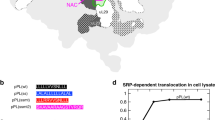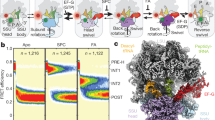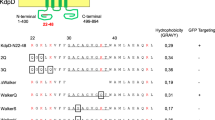Abstract
Cotranslational targeting directly couples synthesis of proteins to their translocation across or insertion into membranes. The signal recognition particle (SRP) and its membrane-bound receptor facilitate the targeting of the translation machinery, the ribosome, via recognition of a signal sequence in the nascent peptide chain. By combining structures of free and ribosome-bound SRP we derive a structural model describing the dynamic nature of SRP when it meets the ribosome.
This is a preview of subscription content, access via your institution
Access options
Subscribe to this journal
Receive 12 print issues and online access
$189.00 per year
only $15.75 per issue
Buy this article
- Purchase on Springer Link
- Instant access to full article PDF
Prices may be subject to local taxes which are calculated during checkout



Similar content being viewed by others
References
Wild, K., Rosendal, K.R. & Sinning, I. A structural step into the SRP cycle. Mol. Microbiol. 53, 357–363 (2004).
Doudna, J.A. & Batey, R.T. Structural insights into the signal recognition particle. Annu. Rev. Biochem. 73, 539–557 (2004).
Keenan, R.J., Freymann, D.M., Stroud, R.M. & Walter, P. The signal recognition particle. Annu. Rev. Biochem. 70, 755–775 (2001).
Koch, H.G., Moser, M. & Muller, M. Signal recognition particle-dependent protein targeting, universal to all kingdoms of life. Rev. Physiol. Biochem. Pharmacol. 146, 55–94 (2003).
Romisch, K., Webb, J., Lingelbach, K., Gausepohl, H. & Dobberstein, B. The 54-kD protein of signal recognition particle contains a methionine-rich RNA binding domain. J. Cell Biol. 111, 1793–1802 (1990).
Zopf, D., Bernstein, H.D., Johnson, A.E. & Walter, P. The methionine-rich domain of the 54 kd protein subunit of the signal recognition particle contains an RNA binding site and can be crosslinked to a signal sequence. EMBO J. 9, 4511–4517 (1990).
Batey, R.T., Rambo, R.P., Lucast, L., Rha, B. & Doudna, J.A. Crystal structure of the ribonucleoprotein core of the signal recognition particle. Science 287, 1232–1239 (2000).
Montoya, G., Kaat, K., Moll, R., Schafer, G. & Sinning, I. The crystal structure of the conserved GTPase of SRP54 from the archaeon Acidianus ambivalens and its comparison with related structures suggests a model for the SRP–SRP receptor complex. Structure Fold Des. 8, 515–525 (2000).
Freymann, D.M., Keenan, R.J., Stroud, R.M. & Walter, P. Functional changes in the structure of the SRP GTPase on binding GDP and Mg2+GDP. Nat. Struct. Biol. 6, 793–801 (1999).
Bacher, G., Lutcke, H., Jungnickel, B., Rapoport, T.A. & Dobberstein, B. Regulation by the ribosome of the GTPase of the signal-recognition particle during protein targeting. Nature 381, 248–251 (1996).
Freymann, D.M., Keenan, R.J., Stroud, R.M. & Walter, P. Structure of the conserved GTPase domain of the signal recognition particle. Nature 385, 361–364 (1997).
Montoya, G., Svensson, C., Luirink, J. & Sinning, I. Crystal structure of the NG domain from the signal-recognition particle receptor FtsY. Nature 385, 365–368 (1997).
Rosendal, K.R., Wild, K., Montoya, G. & Sinning, I. Crystal structure of the complete core of archaeal signal recognition particle and implications for interdomain communication. Proc. Natl. Acad. Sci. USA 100, 14701–14706 (2003).
Rapiejko, P.J. & Gilmore, R. Signal sequence recognition and targeting of ribosomes to the endoplasmic reticulum by the signal recognition particle do not require GTP. Mol. Biol. Cell 5, 887–897 (1994).
Luirink, J. & Sinning, I. SRP-mediated protein targeting: structure and function revisited. Biochim. Biophys. Acta (in the press).
Nagai, K. et al. Structure, function and evolution of the signal recognition particle. EMBO J. 22, 3479–3485 (2003).
Halic, M. et al. Structure of the signal recognition particle interacting with the elongation-arrested ribosome. Nature 427, 808–814 (2004).
Focia, P.J., Shepotinovskaya, I.V., Seidler, J.A. & Freymann, D.M. Heterodimeric GTPase core of the SRP targeting complex. Science 303, 373–377 (2004).
Egea, P.F. et al. Substrate twinning activates the signal recognition particle and its receptor. Nature 427, 215–221 (2004).
Diener, J.L. & Wilson, C. Role of SRP19 in assembly of the Archaeoglobus fulgidus signal recognition particle. Biochemistry 39, 12862–12874 (2000).
Keenan, R.J., Freymann, D.M., Walter, P. & Stroud, R.M. Crystal structure of the signal sequence binding subunit of the signal recognition particle. Cell 94, 181–191 (1998).
Gu, S.Q., Peske, F., Wieden, H.J., Rodnina, M.V. & Wintermeyer, W. The signal recognition particle binds to protein L23 at the peptide exit of the Escherichia coli ribosome. RNA 9, 566–573 (2003).
Pool, M.R., Stumm, J., Fulga, T.A., Sinning, I. & Dobberstein, B. Distinct modes of signal recognition particle interaction with the ribosome. Science 297, 1345–1348 (2002).
Ullers, R.S. et al. Interplay of signal recognition particle and trigger factor at L23 near the nascent chain exit site on the Escherichia coli ribosome. J. Cell Biol. 161, 679–684 (2003).
Cleverley, R.M. & Gierasch, L.M. Mapping the signal sequence-binding site on SRP reveals a significant role for the NG domain. J. Biol. Chem. 277, 46763–46768 (2002).
Wiedmann, M., Kurzchalia, T.V., Bielka, H. & Rapoport, T.A. Direct probing of the interaction between the signal sequence of nascent preprolactin and the signal recognition particle by specific cross-linking. J. Cell Biol. 104, 201–208 (1987).
Walter, P., Ibrahimi, I. & Blobel, G. Translocation of proteins across the endoplasmic reticulum. I. Signal recognition protein (SRP) binds to in vitro-assembled polysomes synthesizing secretory protein. J. Cell Biol. 91, 545–550 (1981).
Terzi, L., Pool, M.R., Dobberstein, B. & Strub, K. Signal recognition particle Alu domain occupies a defined site at the ribosomal subunit interface upon signal sequence recognition. Biochemistry 43, 107–117 (2004).
Flanagan, J.J. et al. Signal recognition particle binds to ribosome-bound signal sequences with fluorescence-detected subnanomolar affinity that does not diminish as the nascent chain lengthens. J. Biol. Chem. 278, 18628–18637 (2003).
Bacher, G., Pool, M. & Dobberstein, B. The ribosome regulates the GTPase of the beta-subunit of the signal recognition particle receptor. J. Cell Biol. 146, 723–730 (1999).
Mandon, E.C., Jiang, Y. & Gilmore, R. Dual recognition of the ribosome and the signal recognition particle by the SRP receptor during protein targeting to the endoplasmic reticulum. J. Cell Biol. 162, 575–585 (2003).
Fulga, T.A., Sinning, I., Dobberstein, B. & Pool, M.R. SRβ coordinates signal sequence release from SRP with ribosome binding to the translocon. EMBO J. 20, 2338–2347 (2001).
Miller, J.D., Wilhelm, H., Gierasch, L., Gilmore, R. & Walter, P. GTP binding and hydrolysis by the signal recognition particle during initiation of protein translocation. Nature 366, 351–354 (1993).
Jagath, J.R., Rodnina, M.V., Lentzen, G. & Wintermeyer, W. Interaction of guanine nucleotides with the signal recognition particle from Escherichia coli. Biochemistry 37, 15408–15413 (1998).
Beckmann, R. et al. Architecture of the protein-conducting channel associated with the translating 80S ribosome. Cell 107, 361–372 (2001).
Acknowledgements
We acknowledge support by European Union (EU) network grant QLK-CT2000-00082 and by the Deutsche Forschungsgemeinschaft (SFB 638) to I.S., by the VolkswagenStiftung, the EU and Senatsverwaltung für Wissenschaft, Forschung und Kultur Berlin, in the context of the Ultra-Structure Network and the Deutsche Forschungsgemeinschaft (SFB 449) to R.B.
Author information
Authors and Affiliations
Corresponding author
Ethics declarations
Competing interests
The authors declare no competing financial interests.
Rights and permissions
About this article
Cite this article
Wild, K., Halic, M., Sinning, I. et al. SRP meets the ribosome. Nat Struct Mol Biol 11, 1049–1053 (2004). https://doi.org/10.1038/nsmb853
Received:
Accepted:
Published:
Issue Date:
DOI: https://doi.org/10.1038/nsmb853
This article is cited by
-
The Perlman syndrome DIS3L2 exoribonuclease safeguards endoplasmic reticulum-targeted mRNA translation and calcium ion homeostasis
Nature Communications (2020)
-
Dual interaction of the Hsp70 J-protein cochaperone Zuotin with the 40S and 60S ribosomal subunits
Nature Structural & Molecular Biology (2016)
-
Cytosolic targeting factor AKR2A captures chloroplast outer membrane-localized client proteins at the ribosome during translation
Nature Communications (2015)
-
An expression map for Anopheles gambiae
BMC Genomics (2011)
-
Structural basis for the molecular evolution of SRP-GTPase activation by protein
Nature Structural & Molecular Biology (2011)



